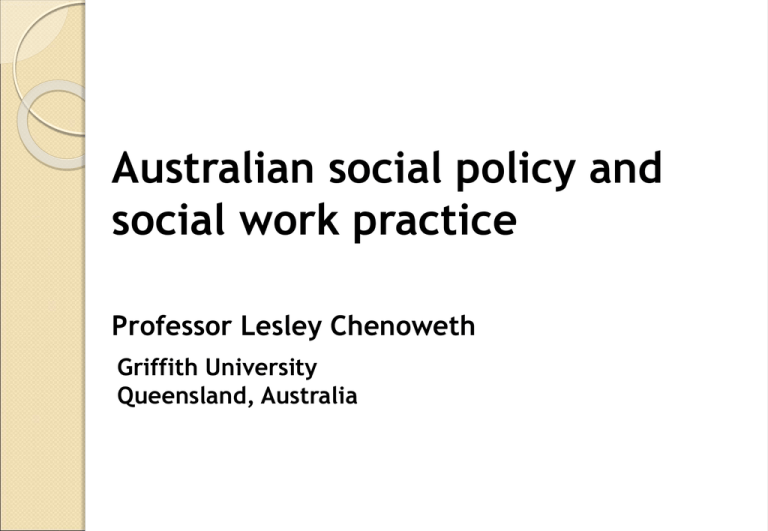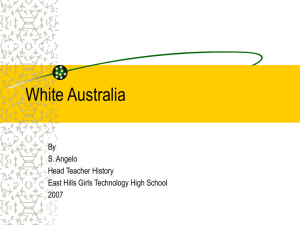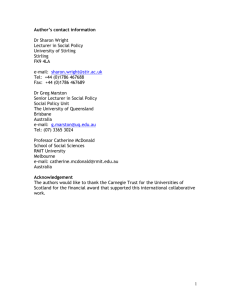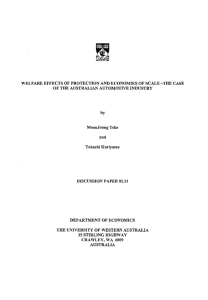Social work in Australia
advertisement

Australian social policy and social work practice Professor Lesley Chenoweth Griffith University Queensland, Australia Overview Australian social welfare overview Social work in Australia Discussion & Questions The Australian context Australian post-war welfare state – British origins Wage earners welfare state (Castles, 1983) Federated model – Commonwealth & State responsibilities Tiers of Government Policy aged care income security Federal Programs education health, housing child protection States Service delivery NGOs Local govt The Australian context Macro changes over the past two decades ◦ ◦ ◦ ◦ Economic globalisation Rise of neo-classical economics New public management Downsizing the welfare state Shift in distribution of income, power & resources The public sector The private sector The bottom 70 % wage /salary earners The top 10 % corporations Small business Big business The ‘bush’ The city Consumers Producers Households The market (Pusey 2003) Welfare reform Gradual dismantling of the welfare state over last 20 years Global economic forces – tariff removals, reconfigured industry and domestic labour market Old reliance on full-time, life long employment now redundant OECD recommendations – undoing of social citizenship rights under income security policies (McDonald & Chenoweth, 2006) Welfare reform Reduction of welfare Initially target- long-term unemployed (1990s) Development of Workfare Focus on obligations rather than rights More recently since 2005 ◦ people with disabilities ◦ single parents Key features of current welfare provisions Highly targeted Funded by general revenue Low levels of payment People on benefits live with significant financial stress Decreasing levels of public support for some payments - eg unemployed (Ziguras, 2006) Social issues – current Child protection Ageing population Health Indigenous Australians Disability Homelessness Refugees and asylum seekers Regional and rural communities The social inclusion agenda Australians enjoy one of the longest life expectancies in the world Life expectancy at birth in top 20 OECD countries: 2005 Japan Switzerland Iceland Australia Spain Sweden Italy France Canada2 Norway New Zealand Austria Ireland Netherlands Greece Luxembourg Germany United Kingdom Finland Belgium Korea 82.1 81.3 81.2 80.9 80.7 80.6 80.4 80.3 80.2 80.1 79.6 79.5 79.4 79.4 79.3 79.3 79.0 79.0 78.9 78.7 78.5 0 2 76 78 80 However Indigenous Australians have an average life expectancy of 59.4 for men and 64.8 for women1 82 Life expectancy at birth (years) For more on Indigenous health and disadvantage, see The Future of 1. 2001 data 2. 2004 data Note: Ireland, Italy and Luxembourg excluded from 2004 OECD life expectancy data Indigenous Australia Source: OECD, Health Data 2005; Productivity Commission, Overcoming Indigenous Disadvantage (2007) "Strategic Areas For Action" Social work in Australia In 1939, the first degree level social work program at Uni of Sydney. In 2010, 26 degree programs across Australia Social work –BSW degree MSW Professional body – Australian Association of Social Workers AASW AASW accredits programs including a 4-year BSocWk, 2-year graduate entry and since 2008, a Masters ‘qualifying’ program (Healy & Lonne, 2010) Social workers employed in: ◦ Federal government– eg Centrelink ◦ State governments – eg child protection , health , disability, mental health ◦ Community sector - large charities, faith based agencies, small to medium organisations ◦ Private practice - increasing 12 Social work in Australia 13 Social work is not a registered profession unlike in UK, USA and New Zealand (Lonne & Duke 2008) Participation rate of low income students in Higher Education is lower than representation in the community, and static since 2002 Significant reforms since 1986 have led to greater co-operation between higher education and Vocational Education sector (in Healy & Lonne, 2010) and improved pathways from VET sector into Higher Education Trends in Social Work and Human Services Human services – 4th fastest industry sector Demand for qualified practitioners is high Rural and remote recruitment and retention Some sectors employing 3 year trained graduates – eg child protection, NGOs Casualisation of workforce More flexible modes of delivery Trends in Social Work and Human Services Decreased professional autonomy Management of risk (Healy& Meagher, 2004; Baines,2006) Move to use of ICT technologies – call centres, on line counselling Use of computer technology for surveillance of clients? Fly in fly out service delivery to remote areas Centrelink • Government agency administers eligibility, payments and compliance Employs large numbers of social workers (650+) Sites of service delivery – offices and call centres Highly technologised (ICT) service delivery Coordinates Australia disaster social work responses eg: Asian tsunami Victorian bushfires Bali bombings On a typical day, Centrelink IT supports 55,000 business function points in 14 million lines of code through 8000 functions on 3200 screens to 31,000 desktops and 400 LAN servers in 1000 sites. This means that 13,000 users concurrently generate 12 million online transactions each day on 14 million customer records (Vardon, 2003) Questions and Discussion • Does Australia have too many levels of government and service delivery? What do you think are the main features of social welfare in Australia? How are they different/ similar to Norway? What do you see as the roles for social workers in Australia? Should Australian social workers become registered?











